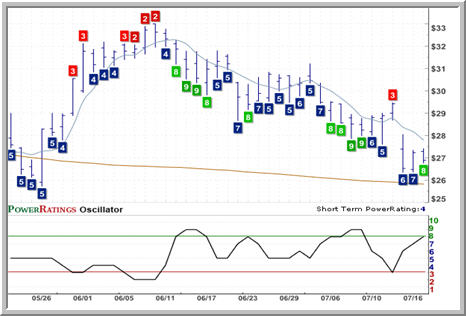PowerRatings, Limit Orders and Trading Big Pullbacks
Want to know the three keys to a short term trading strategy for stocks that only has you buying when the edges are the greatest?
PowerRatings. Limit Orders. And Big Pullbacks.
Our PowerRatings, of course, help traders find the best stocks to trade every day. In rating stocks from 1 to 10 – with the highest rated stocks being those that have historically performed best against the average stock in the short term – our PowerRatings provide short term traders with a handy guide to some of the best opportunities in the market.
Moreover, our PowerRatings are based on more than a decade of quantified, backtested simulated short term trades. While past performance is no guarantee of future results, the performance of our highest PowerRatings stocks – through 2008, as shown in this special report – continues to hold up impressively.
Click here to read: PowerRatings Does It Again – Results for 2008.
The second key to trading successfully with PowerRatings is to use limit orders. Our research has found that by waiting to buy below the market of a high PowerRating stock, the chances that the stock will outperform the average stock actually increase. This strategy of waiting for what we call “intraday weakness” means that traders are only buying stocks when sellers are at their most aggressive and most likely to sell “merchandise” at a price below its value.

Figure 1. J.B. Hunt Transportation Services
(
JBHT |
Quote |
Chart |
News |
PowerRating) – The green highlighted numbers indicate closes with PowerRatings of 8 or higher. In all three instances in the above chart, traders who bought below the market when high PowerRatings appeared would have been rewarded with strength to sell into after a few days.
The third key to trading successfully with PowerRatings lies in big pullbacks – and the bigger the better. How big? How about a 5%, 6% or even 7% pullback before considering taking a position in a stock?
Remember that the path to high probability trading – in stocks as well as exchange-traded funds (ETFs) – lies in buying oversold markets and selling short overbought markets. The more oversold a market is, assuming it is trading above its 200-day moving average, the more likely it is to “snap back” powerfully once the profit-taking and selling runs its course.
So when we are looking (1) to buy a high PowerRating stocks with (2) a limit order below the market, we (3) want that limit order to buy to be as low as possible. In our testing, 5-7% below the previous close provided an excellent combination of high quality trades and reasonable trade frequency.
Following these three keys to trading PowerRatings stocks will ensure you are taking advantage of all the key edges that make our PowerRatings such an effective tool for short term traders.
Our highest Short Term PowerRatings stocks have outperformed the average stock by a margin of more than 14 to 1 after five days. Click here to start your free, 7-day trial to our Short Term PowerRatings!
David Penn is Editor in Chief at TradingMarkets.com.
